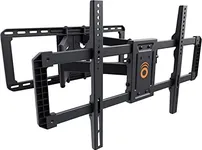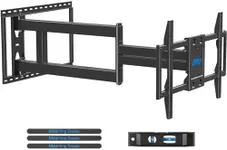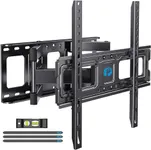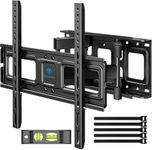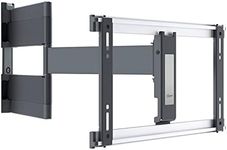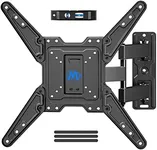Buying Guide for the Best Full Motion TV Wall Mounts
Choosing a full-motion TV wall mount can make a big difference in how you enjoy your television. These mounts allow you to move your TV in different directions, making it easier to get the best viewing angle from anywhere in the room. When picking the right one, it's important to consider your TV size, the layout of your room, and how much flexibility you want in positioning your TV. Understanding the key features will help you make a choice that fits your needs and ensures your TV is both secure and easy to use.VESA CompatibilityVESA refers to the standardized distance between the mounting holes on the back of your TV. This is important because your wall mount must match your TV’s VESA pattern to ensure a secure fit. VESA patterns are usually measured in millimeters, such as 200x200, 400x400, or 600x400. Smaller TVs tend to have smaller VESA patterns, while larger TVs have bigger ones. To pick the right mount, check your TV’s manual or the back of your TV for the VESA size, and make sure the mount you choose supports it.
Weight CapacityWeight capacity tells you the maximum weight the wall mount can safely hold. This is crucial for safety, as using a mount that can't support your TV's weight could lead to damage or accidents. Mounts are rated for different weight ranges, such as up to 40kg, 60kg, or even more. Always check your TV’s weight (including any accessories) and choose a mount that can handle a bit more than that to be safe.
Extension and Swivel RangeExtension and swivel range describe how far the mount can pull your TV away from the wall and how much it can turn left or right. Some mounts extend just a few inches, while others can pull out over 20 inches. Swivel range is usually measured in degrees, with some mounts offering up to 180 degrees of movement. If you want to watch TV from different parts of the room or reduce glare, a greater extension and swivel range is helpful. If your TV will mostly face one direction, a smaller range may be enough.
Tilt AdjustmentTilt adjustment lets you angle your TV up or down. This is useful for reducing glare from lights or windows and for getting a better viewing angle if your TV is mounted higher on the wall. Tilt ranges can vary, with some mounts offering just a few degrees and others up to 15 degrees or more. If you plan to mount your TV above eye level, look for a mount with a good tilt range.
Wall CompatibilityWall compatibility refers to the types of walls the mount can be safely attached to, such as drywall with studs, concrete, or brick. Not all mounts are suitable for every wall type, and using the wrong one can be unsafe. Check what kind of wall you have and make sure the mount includes the right hardware or is rated for your wall type. If you’re unsure, it’s best to consult a professional.
Cable ManagementCable management features help you keep your TV’s power and signal cables organized and out of sight. Some mounts have built-in channels or clips for this purpose. Good cable management not only looks neater but also helps prevent cables from getting pinched or damaged when you move the TV. If you want a clean look or plan to move your TV often, look for mounts with cable management options.
Ease of InstallationEase of installation refers to how simple it is to mount your TV on the wall. Some mounts come with clear instructions, templates, and all the necessary hardware, while others may be more complicated. If you’re planning to install the mount yourself, look for one with good reviews for easy installation and clear instructions. If you’re not comfortable with DIY projects, you might want to consider professional installation.






